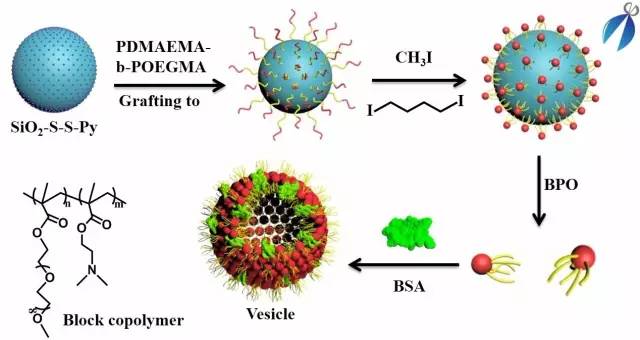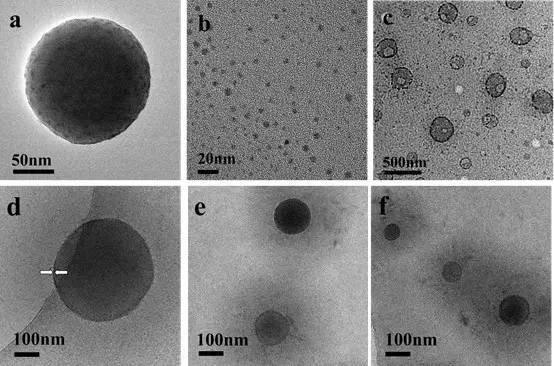In these years, the developments in the synthesis and self-assembly of patchy nanoparticles have aroused increasing attention. Co-assembly of polymeric nanoparticles and protein molecules combines the advantages of polymeric materials and biomolecules, and will produce new functional materials.
 
In this research, patchy micelles with quaternized poly(2-(dimethylamino)ethyl methacrylate) (PDMAEMA) cores and poly (oligo (ethylene glycol) monomethyl ether methacrylate) (POEGMA) coronae were prepared by using block copolymer brushes as templates. The patchy micelles can make co-assembly with protein molecules in neutral water (Refer to the previous scheme). Bovine serum albumin (BSA) has similar size to the patchy micelles, and are negatively charged in neutral water, so it was employed as a model protein. Depending on the hydrophobic/hydrophilic interactions, amphiphilic polymer protein conjugates are able to self-assemble into nanostructures, such as micelles, capsules and vesicles. Herein, native protein molecules were used directly to make co-assembly with polymer particles.
In the mono-layer walls, pinned micelles bind to the BSA molecules through electrostatic interaction, and the water-soluble POEGMA chains in the coronae stabilize the structures. The size of the assembled structure decreases with the molar ratio of BSA to pinned micelles. The molar ratio of BSA to the pinned micelles exerts a significant effect on the size of the assembled structures. The vesicle walls are composed of mono-layer pinned micelles and POEGMA chains extend from the inner and outer wall surfaces into aqueous phase to stabilize the self-assembled structures. The patchy structure provides possibilities for the directional interaction of the pinned micelles with BSA molecules, and inhibits random particle coagulation upon mixing of the two components.
Positively charged pinned micelles with patchy structures were prepared by cleavage of block copolymer brushes in a selective solvent. The pinned micelles can make co-assembly with negatively charged BSA molecules into vesicle structures. The average size of the structures can be controlled by the molar ratio of BSA to pinned micelles. The patchy structure of the micelle is a key structural factor in the self-assembly process, and the electrostatic interaction between the pinned micelles and protein molecules provides driving force for the self-assembly.
This research provides a unique method for the fabrication of hybrid nanostructures with both polymer properties and protein functionalities. Breakthroughs in the synthesis and self-assembly of patchy particles pave new avenues for fabrication of complex hierarchical structures with unique properties.
For the detailed information of this literature, please click here:
http://onlinelibrary.wiley.com/doi/10.1002/ange.201704955/full
| 

 Position:
Home
>>
News
>>
正文
Position:
Home
>>
News
>>
正文

